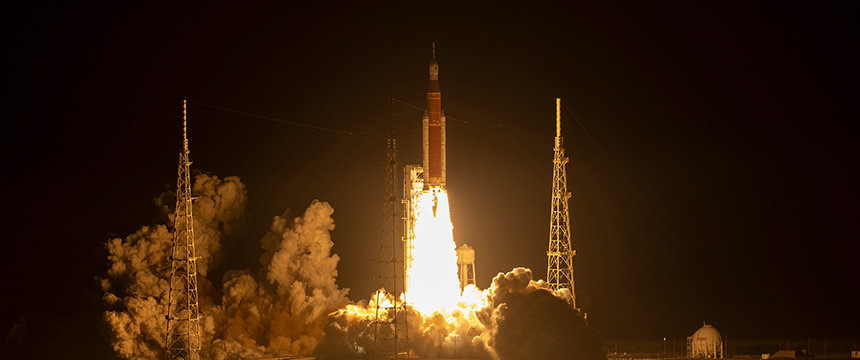Private Space Activity and the Advantages of U.S. Patents for Protecting Space Inventions

In 2025, the National Aeronautics and Space Administration (NASA) is scheduled to once again bring man and machine to the lunar surface, this time under the name of the Greek goddess Artemis. However, the means to the ends have changed. The new Artemis missions lean more heavily on the aid of private space companies than their predecessor Apollo missions1, with private enterprises developing the systems, stations, and vehicles to make the ten proposed Artemis missions a reality.
Not only is NASA using private companies, but the United States Air Force (USAF) and United States Space Force (USSF) also rely on private space innovation to varying degrees. Programs such as AFWERX and SpaceWERX have allowed the United States military to accelerate the development of cutting-edge technology and collaborate with dual-use space tech startups. In fact, the private space industry is projected to increase to more than US$1 trillion by 2040, attracting both private and public investment.2
With these rapid increases in funding and activity, private space companies can look to patents to protect their technologies. The United States patent system, in particular, anticipates some of the challenges that arise with inventions that are used in outer space.
Rapid Increases in Orbital Launches and Satellite Deployments
With the involvement of private space companies, orbital space launch attempts nearly quadrupled in the United States, increasing from 20 in 2015 to nearly 80 in 2022. China has also made significant strides, increasing its total orbital space launch attempts from 19 in 2015 to 64 in 2022. The chart below shows orbital launch attempts from 2015 to 2022 for the entities with the most orbital launches: United States, China, Europe, and Russia.

Orbital Launch Attempts by Country3
The number of payloads (e.g., satellites) launched have increased even more dramatically. For example, total payload launches in the United States exploded nearly 1,700% in only seven years, from 112 in 2015 to almost two thousand in 2022. The United States currently boasts having 4,511 active satellites in orbit as of April 2023, with China as the runner-up at 584.4 Globally, the majority of satellites, 7,932 in total, are in a low earth orbit (LEO) and serve commercial purposes.5

Payloads Launched by Country6
The Corresponding Increase in Global Patent Filings for Space Technology
Patent filings for space tech have followed this global increase in space activity. While the United States, China, Russia, and Europe have all seen increases in patent grants, China has seen the most dramatic increase. The below chart illustrates patent grants per year in the United States, China, Russia, and Europe in two combined space tech CPC categories: Satellite Systems (H04B 7/185) and Cosmonautics (B64G).

Patents Granted per Year for Cosmonautics and Satellite Systems
CPC categories are tags that help track the different types of technologies for which patent applications are filed.
Inventions In Outer Space – 35 U.S.C. § 105
While Chinese space patents have undergone the most rapid increase in grants, the United States offers a unique and advantageous statute for patent owners—35 U.S.C. § 105, which recites:
(a) Any invention made, used or sold in outer space on a space object or component thereof under the jurisdiction or control of the United States shall be considered to be made, used or sold within the United States for the purposes of this title, except with respect to any space object or component thereof that is specifically identified and otherwise provided for by an international agreement to which the United States is a party, or with respect to any space object or component thereof that is carried on the registry of a foreign state in accordance with the Convention on Registration of Objects Launched into Outer Space.
(b) Any invention made, used or sold in outer space on a space object or component thereof that is carried on the registry of a foreign state in accordance with the Convention on Registration of Objects Launched into Outer Space, shall be considered to be made, used or sold within the United States for the purposes of this title if specifically so agreed in an international agreement between the United States and the state of registry.
Normally, for a patent of a particular jurisdiction to be infringed, the infringing product would need to be made, used, or sold within that jurisdiction. But what about inventions used in outer space? 35 U.S.C. § 105 provides a unique answer to this question: “[a]ny invention made, used or sold in outer space on a space object or component thereof under the jurisdiction or control of the United States shall be considered to be made, used or sold within the United States [emphasis added].”
Impact
This statute means that if a claim requires manufacturing steps or actual use, infringement of a United States patent can still be shown if the invention is manufactured or used in space. This is important for methods that are primarily performed in outer space, such as zero gravity drug manufacturing, sample collection on asteroids, space craft or station assembly, orbital maneuvering, space debris collection, and habitat manufacture or assembly.
It is important to note an exception. There can be infringement under 35 U.S.C. § 105(a) only if the space object in question is not registered in a foreign state and is under the jurisdiction and control of the United States. Furthermore, space objects can be registered in a foreign state and then launched from a spaceport within the United States.8 Given the strong space activity occurring within the United States, and the advantages of United States patent law, the United States remains a prime target for developing patent portfolios and can serve as a cornerstone for space related patent families.
Of course, a robust patent portfolio includes not only United States filings, but international patent families. While the United States provides the advantages of 35 U.S.C. § 105, most jurisdictions (such as Europe, Russia, and China) do not.7 Standard claim drafting practices should be employed for space inventions, and these techniques are important in non-U.S. jurisdictions. Claims should be drafted so that they do not require use to be infringed, and therefore can be infringed by manufacturing the product on Earth, or simply letting the product sit on the shelf.
The space race is back: this time with increased private involvement. Patent protection is one way for businesses to set themselves apart from their peers in this new dynamic environment, protect their investments in technology, and achieve out-of-this-world wins.
1 Kluger, J. “NASA Is Working With Private Companies to Go Back to the Moon. That’s Riskier Than it Seems.” TIME Magazine, 31 July 2019.
2 “Space: Investing in the Final Frontier.” Morgan Stanley, 24 July 2020.
3 McDowell, J. “Space Activities in 2022.” 17 January 2023.
4 Andy. “How many satellites are orbiting the Earth in 2023?” Pixalytics, 5 July 2023.
5 “Orbiting Now: Active Satellite Orbit Data.” orbit.ing-now.com, accessed 23 October 2023.
6 McDowell, J. “Space Activities in 2022.” 17 January 2023.
7 “Patents and space-related inventions.” The European Space Agency, accessed 23 October 2023.
8 “Information furnished in conformity with the Convention on Registration of Objects Launched into Outer Space.” Government of Belgium, 29 August 2023.
